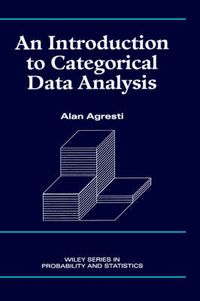
An Introduction to Categorical Data Analysis Upplaga 1
Concise, complete, nontechnical; the ideal introduction to an increasingly important topic In recent years, the use of statistical methods for categorical data has increased dramatically in a variety of areas and applications. This book provides an applied introduction to the most important methods for analyzing categorical data. It summarizes methods that have long played a prominent role, such as chi-squared tests, but places special emphasis on logistic regression and loglinear modeling techniques.
Special features of the book include:
Emphasis on logistic regression modeling of binary data and Poisson regression modeling of count data
A unified perspective, based on generalized linear models, that connects these methods with standard regression methods for normally-distributed data
An appendix showing the use of a new SAS procedure (GENMOD) for generalized linear modeling that can conduct nearly all methods presented in the book
An entertaining historical perspective of the development of the methods
Specialized methods for ordinal data, small samples, multicategory data, and matched pairs
More than 100 examples of real data sets and more than 200 exercises
Writing in an applied, nontechnical style, Alan Agresti illustrates methods using a wide variety of real data, including alcohol, cigarette, and marijuana use by teenagers; AZT use and delay of AIDS; space shuttle launches and O-ring failure; passive smoking and lung cancer; and much more. An Introduction to Categorical Data Analysis is an invaluable tool for social, behavioral, and biomedical scientists, as well as researchers in public health, marketing, education, biological and agricultural sciences, and industrial quality control.
An Instructor's Manual presenting detailed solutions to all the problems in the book is available from the Wiley editorial department.
Upplaga: 1a upplagan
Utgiven: 1996
ISBN: 9780471113386
Förlag: John Wiley & Sons
Format: Inbunden
Språk: Engelska
Sidor: 312 st
Concise, complete, nontechnical; the ideal introduction to an increasingly important topic In recent years, the use of statistical methods for categorical data has increased dramatically in a variety of areas and applications. This book provides an applied introduction to the most important methods for analyzing categorical data. It summarizes methods that have long played a prominent role, such as chi-squared tests, but places special emphasis on logistic regression and loglinear modeling techniques.
Special features of the book include:
Emphasis on logistic regression modeling of binary data and Poisson regression modeling of count data
A unified perspective, based on generalized linear models, that connects these methods with standard regression methods for normally-distributed data
An appendix showing the use of a new SAS procedure (GENMOD) for generalized linear modeling that can conduct nearly all methods presented in the book
An entertaining historical perspective of the development of the methods
Specialized methods for ordinal data, small samples, multicategory data, and matched pairs
More than 100 examples of real data sets and more than 200 exercises
Writing in an applied, nontechnical style, Alan Agresti illustrates methods using a wide variety of real data, including alcohol, cigarette, and marijuana use by teenagers; AZT use and delay of AIDS; space shuttle launches and O-ring failure; passive smoking and lung cancer; and much more. An Introduction to Categorical Data Analysis is an invaluable tool for social, behavioral, and biomedical scientists, as well as researchers in public health, marketing, education, biological and agricultural sciences, and industrial quality control.
An Instructor's Manual presenting detailed solutions to all the problems in the book is available from the Wiley editorial department.
Begagnad bok (0 st)
Varje vecka tillkommer tusentals nya säljare. Bevaka boken så får du meddelande när den finns tillgänglig igen.



